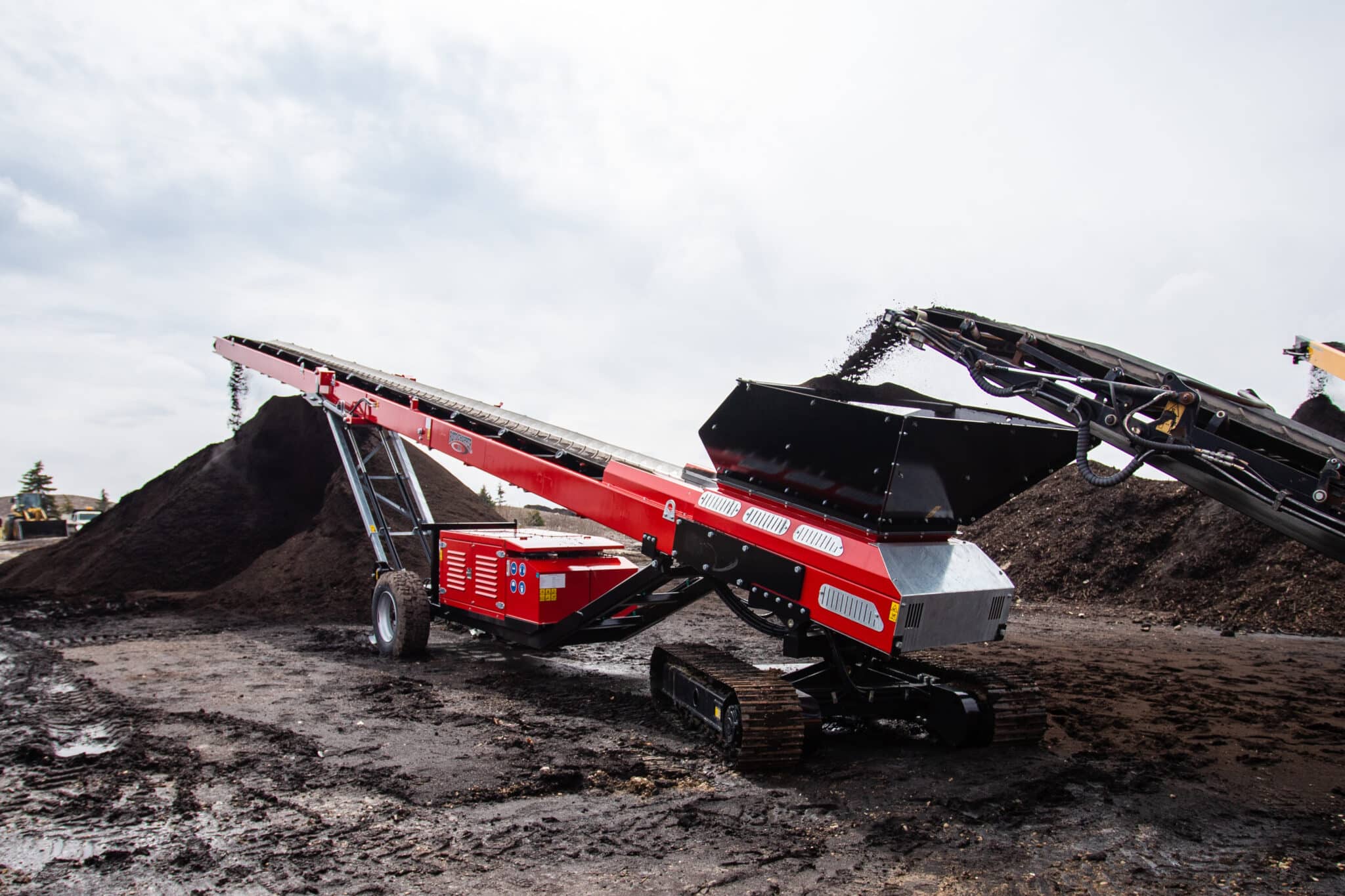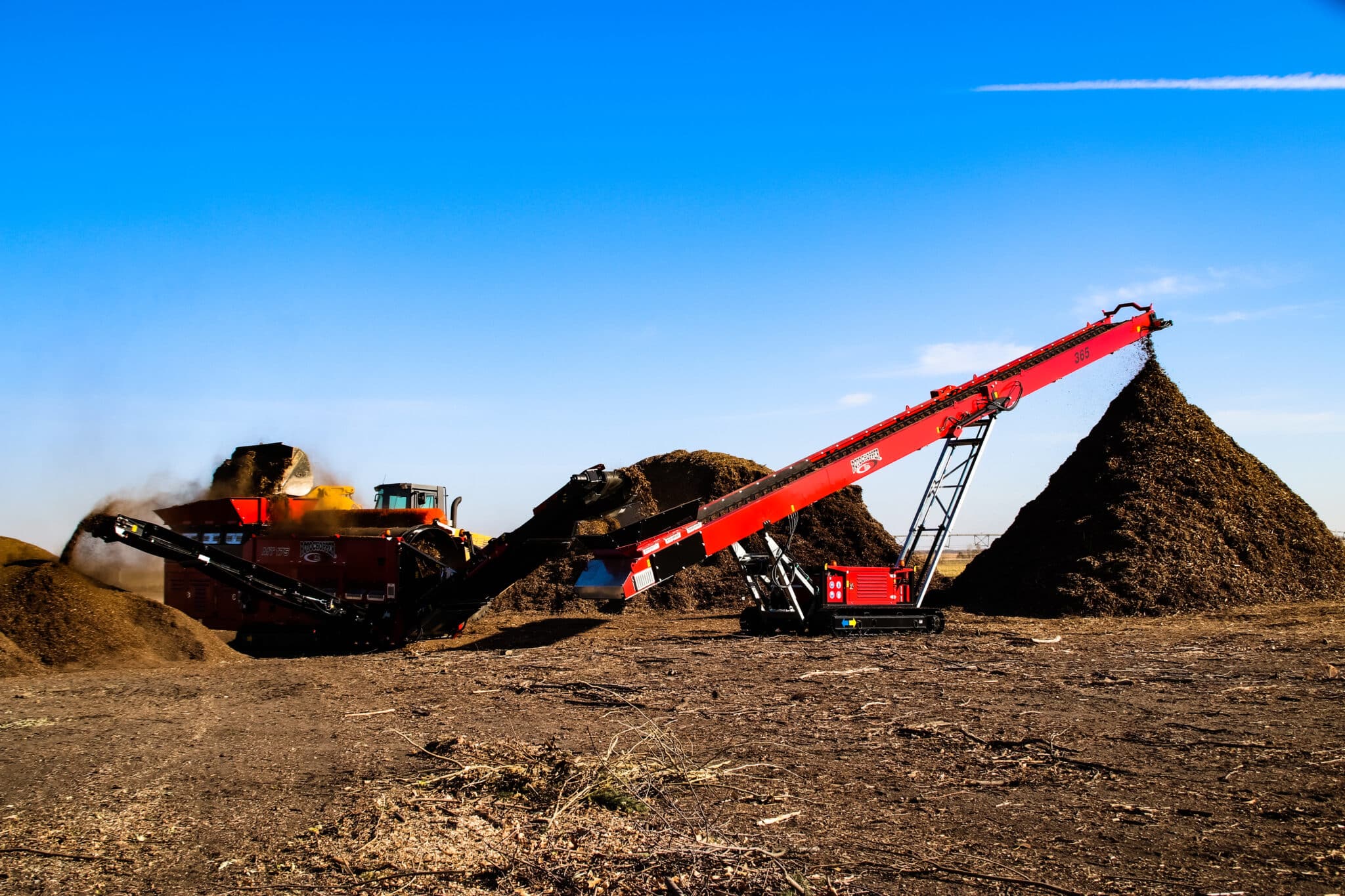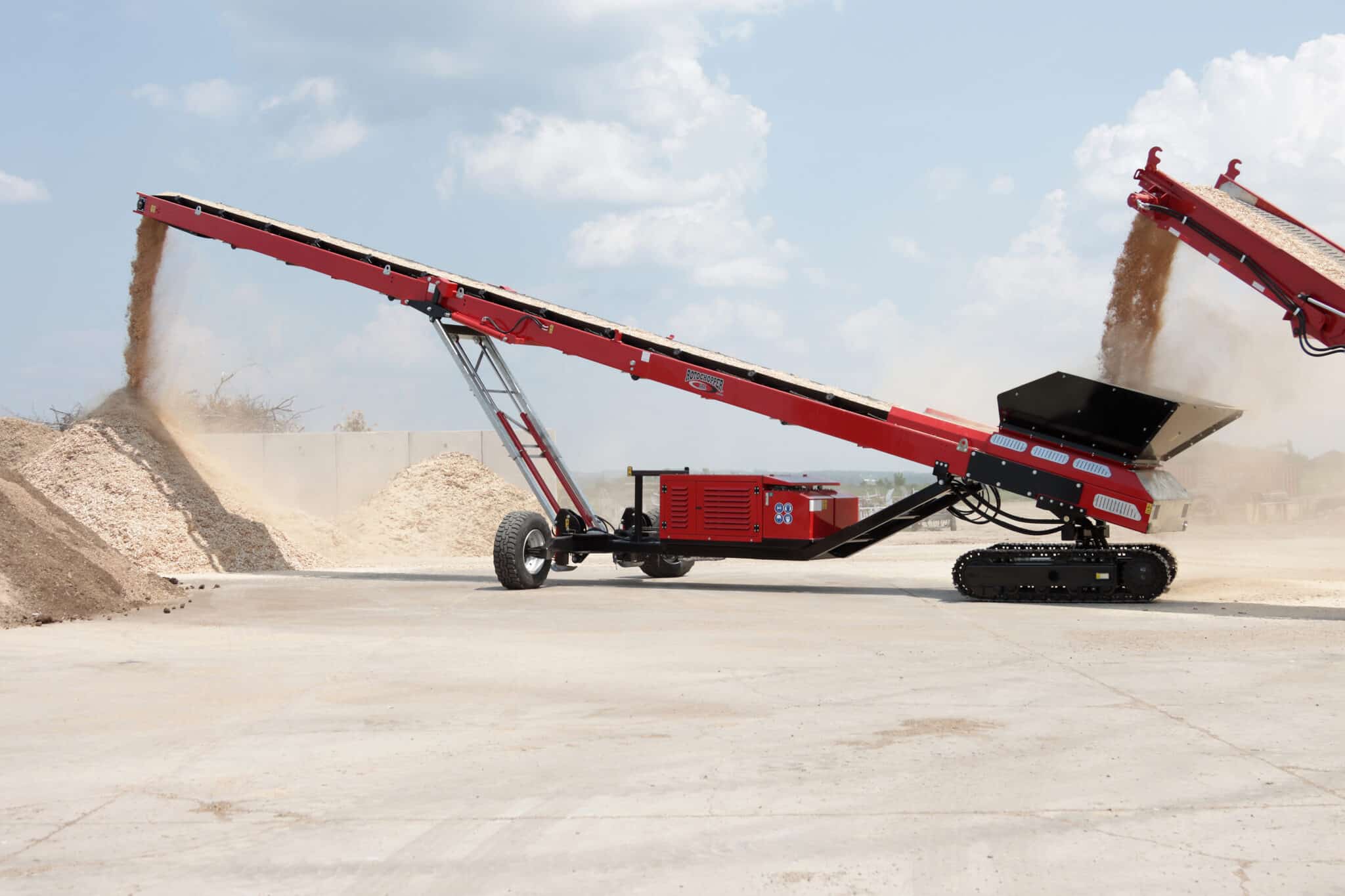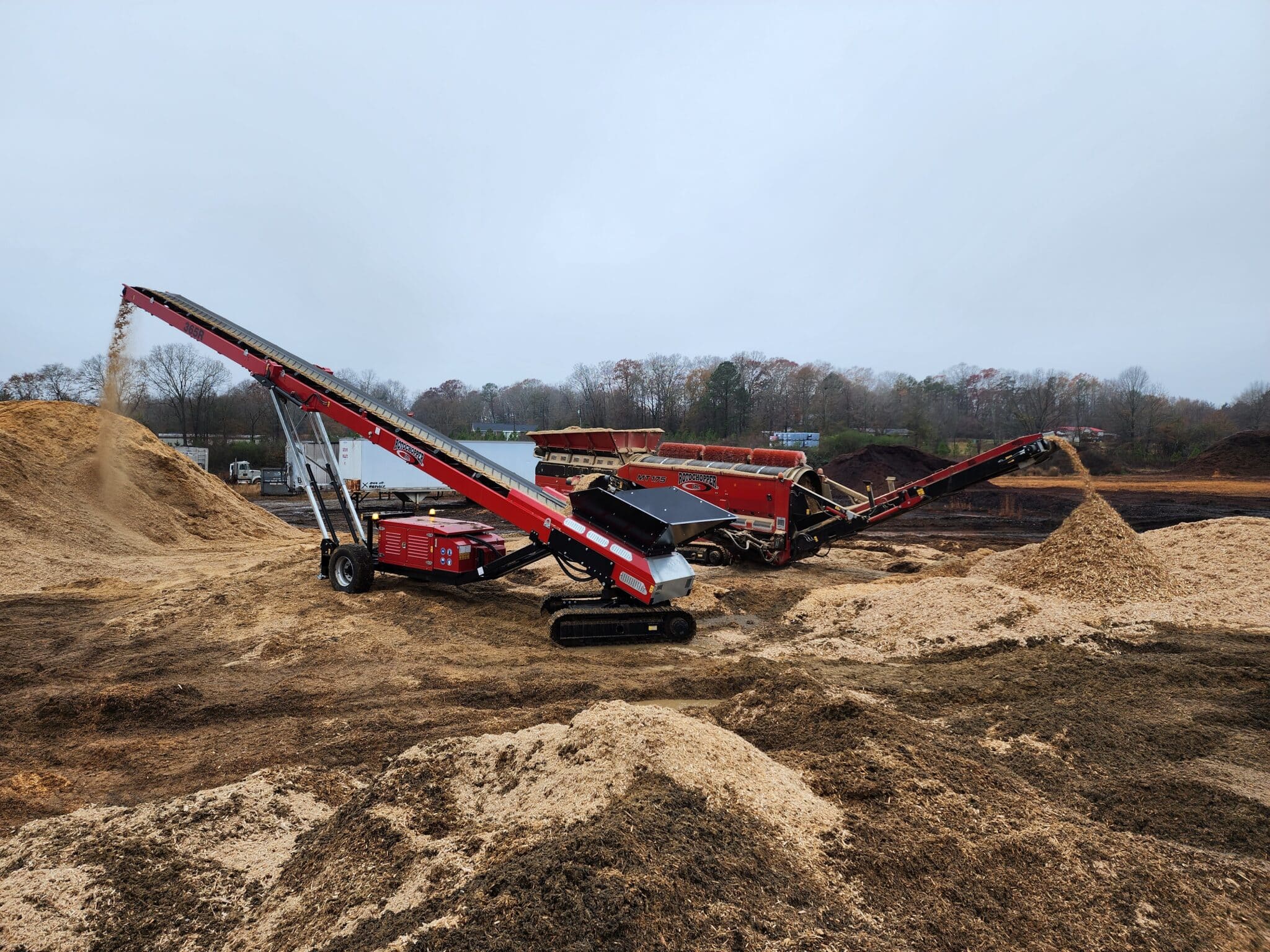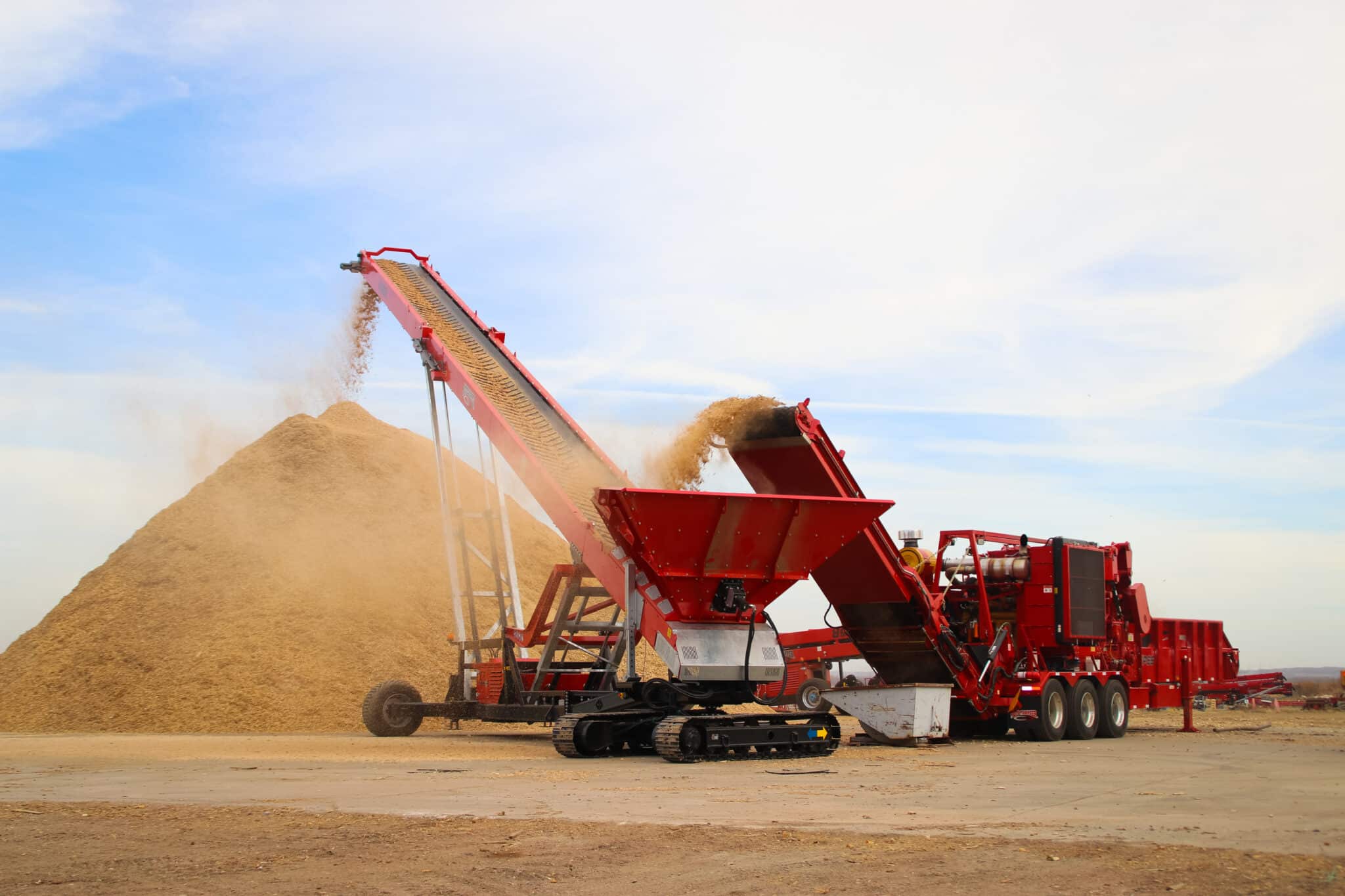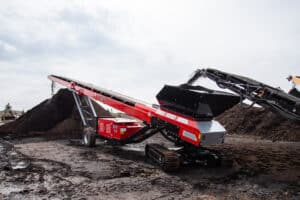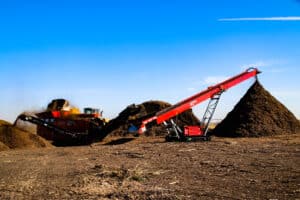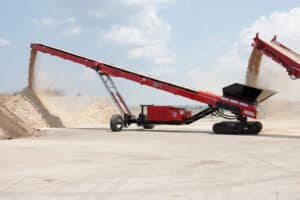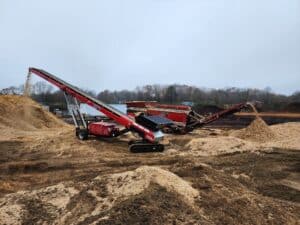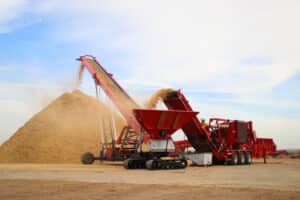In the waste reduction industry, a successful operation relies on several essential systems and processes to ensure industrial waste is safely repurposed or disposed of—this includes horizontal grinders, baggers, shredders, and more. Conveyor systems also play a critical role in effective waste management systems, eliminating unnecessary feedstock handling, boosting worksite efficiency, and improving employee safety.
Traditionally, worksites have used loaders like skid steers or backhoes to manually pile end product. This method requires several machines, workers to operate them, and time to repeatedly haul feedstock up the stack. Conveyor systems, on the other hand, continuously transport feedstock straight from a grinder or other machine to the top of a stack—without the help of additional vehicles. This allows project managers and business owners to cut down on the cost of labor, fuel, and equipment.
Safe Operation of Conveyor Systems
Conveyor systems offer several advantages for workplace safety. Traditional methods of stacking processed feedstock require loaders to repeatedly move across piles of material. If moved into a precarious position, the loader could lose traction and stability, endangering the driver, their loader, and the material itself. Driving heavy machinery over processed feedstock, like wood chips or mulch, can also compact the material, risking ignition if it is subjected to heat or friction.
Conveyor systems eliminate the need for loaders by automatically transporting feedstock from processing equipment to the end product pile, making fire hazards and loader accidents very unlikely.
While conveyor systems effectively improve operational safety, they are still heavy machines. Just like any piece of industrial equipment, operators should always follow proper safety procedures to reduce the chances of an accident. Regardless of the type of conveyor your operation utilizes, there are a few best practices all workers should bear in mind when working on or near a conveyor system.
Wear Proper Protective Equipment and Secure Loose Accessories
When operating near a conveyor system, all workers should be dressed in appropriate personal protective equipment (PPE)—including hard hats and safety shoes. Employees should not be wearing loose clothing or dangling jewelry, and long hair should always be tied back to avoid getting caught in the conveyor’s rollers or pinch points.
Know How to Respond to an Emergency
In an emergency, every worker near the conveyor should know where the conveyor’s emergency shutoff is located and how to use it. A swift shutdown can be the difference between an operational inconvenience and a serious injury.
Train Workers on Proper Conveyor Safety
Of course, the best way to prevent workplace accidents and ensure smooth operation is to keep your machinery well-maintained and properly train workers on safe conveyor operation. After their initial safety training, all workers should have access to relevant safety manuals and understand the danger these machines can pose if proper protocols are not observed.
In the horizontal grinding and waste reduction industries, fire safety is especially important. Heat-producing aspects of the conveyor should be kept clean, and flammable materials, like grease and cardboard, should be stored safely away from the machine. Ensure your employees are trained on and following end-of-day fire prevention shutdown guidelines, including removing dust and debris from the conveyor and checking critical components for safe operating temperatures.
Maintaining Your Conveyor System
Just like any piece of equipment, conveyor systems require regular maintenance to stay safe. Comprehensive preventative maintenance programs can help keep your conveyor system functioning at peak efficiency, but there are a few inevitable maintenance tasks operators can handle themselves, including routine cleaning, damage assessment, and belt tension and alignment issues.
Cleaning Your Conveyor System
Most conveyor systems operate using rollers and belts to move feedstock. When feedstock falls through the cracks between these elements, it can collect on the conveyor’s wheels and rollers, slowing down the entire system and increasing the risk of equipment damage. Thoroughly cleaning the entire conveyor system at the end of each day maximizes the system’s efficiency and ensures it stays debris-free.
Assessing Damage to Your System
A conveyor’s belt is one of its most critical aspects. During everyday use, conveyor belts encounter a large amount of feedstock, which, over time, can wear the belt down. To keep your conveyor system running smoothly, regularly check your belts for signs of damage, including cuts, cracks, tears, and general wear. If problems are found, contact your maintenance partner or parts supplier immediately to minimize downtime and keep your operation safe.
Checking for Belt Problems
During operation, conveyor belts can become misaligned, losing contact with the conveyor rollers and causing slippage. Belt slippage can decrease throughput and even stop your conveyor system entirely, so inspect belts regularly to ensure they are properly aligned.
Slippage can also occur as belts lose tension over time. Conveyor operators should inspect the belt at regular intervals to ensure its tension is within acceptable limits. Ideally, conveyor belts should be set to the lowest possible tension that doesn’t cause slippage, as setting the tension too high can cause unnecessary wear and tear.
What to Look for in a Conveyor System
Conveyors can radically boost the profitability of an industrial operation, but finding the system that matches your operation’s unique needs is key to maximizing efficiency. Conveyor systems vary by size, mobility, structure, and more. Before making a purchase, project managers and business owners should understand the differences between conveyor systems.
Conveyor Size and Length
Conveyor systems come in a variety of lengths and heights to accommodate different sizes of end product piles. Most systems feature lengths that range from around 21 feet to 34 feet. When it comes to conveyor systems, bigger doesn’t necessarily mean better—project managers should keep their specific site and length requirements in mind when selecting a conveyor system.
Radial vs. Non-Radial Conveyors
Conveyor systems come in two main varieties: radial and non-radial. Non-radial systems move feedstock from one location to another—they’re simple, fast, and effective. Radial conveyor systems pivot, allowing operators to sort feedstock based on size, color, and more while reducing unnecessary material handling.
While non-radial systems are ideal for transporting feedstock across a worksite, into a truck, or to the next step in the processing workflow, radial systems are designed to evenly blend and distribute feedstock during processing, improving the end product’s overall size and color consistency.
Conveyor Mobility
Most modern conveyor systems are designed with mobility in mind, making them effective on worksites of varying sizes and elevations. The two most common types of mobile conveyor systems are wheeled and tracked systems. Wheeled systems are typically less expensive and easier to maintain, while tracked systems are durable and can easily handle rough terrain and inclines.
Technology Level
Even though conveyor technology has been in use for decades, innovation has not stagnated. Over the last several years, numerous advancements in conveyor technology have improved energy efficiency and decreased noise levels.
Choose the Conveyor System that Works for You
With so many options available, choosing a conveyor system that fits into your existing waste processing operation can be daunting. Project managers, business owners, and equipment operators should keep the constraints of their operation in mind and purchase a conveyor system suited to their worksite and business goals.
Before committing to a purchase, it’s important to examine all available options and research the conveyor manufacturer. The right system—engineered and supported by a trustworthy partner with your operation’s best interests at heart—can help foster a more productive, more environmentally friendly, and overall safer worksite.

